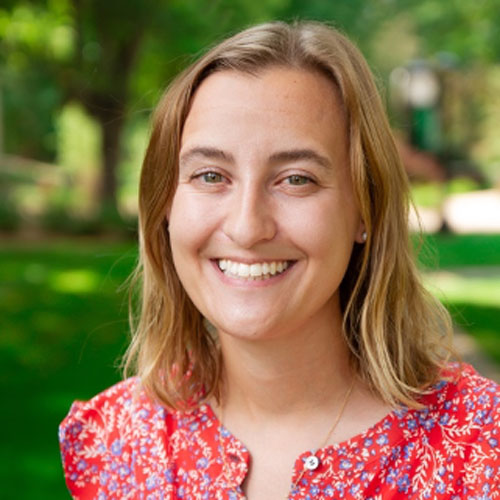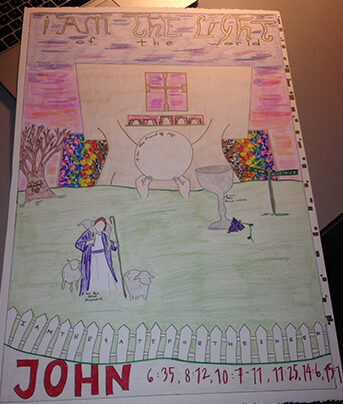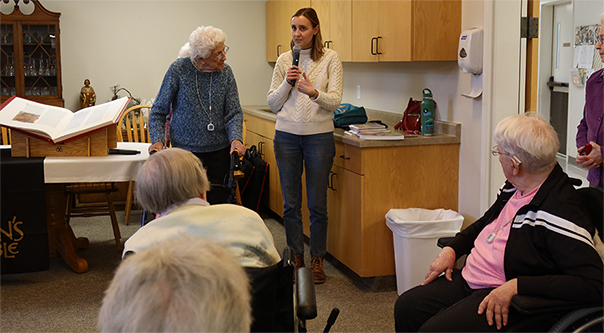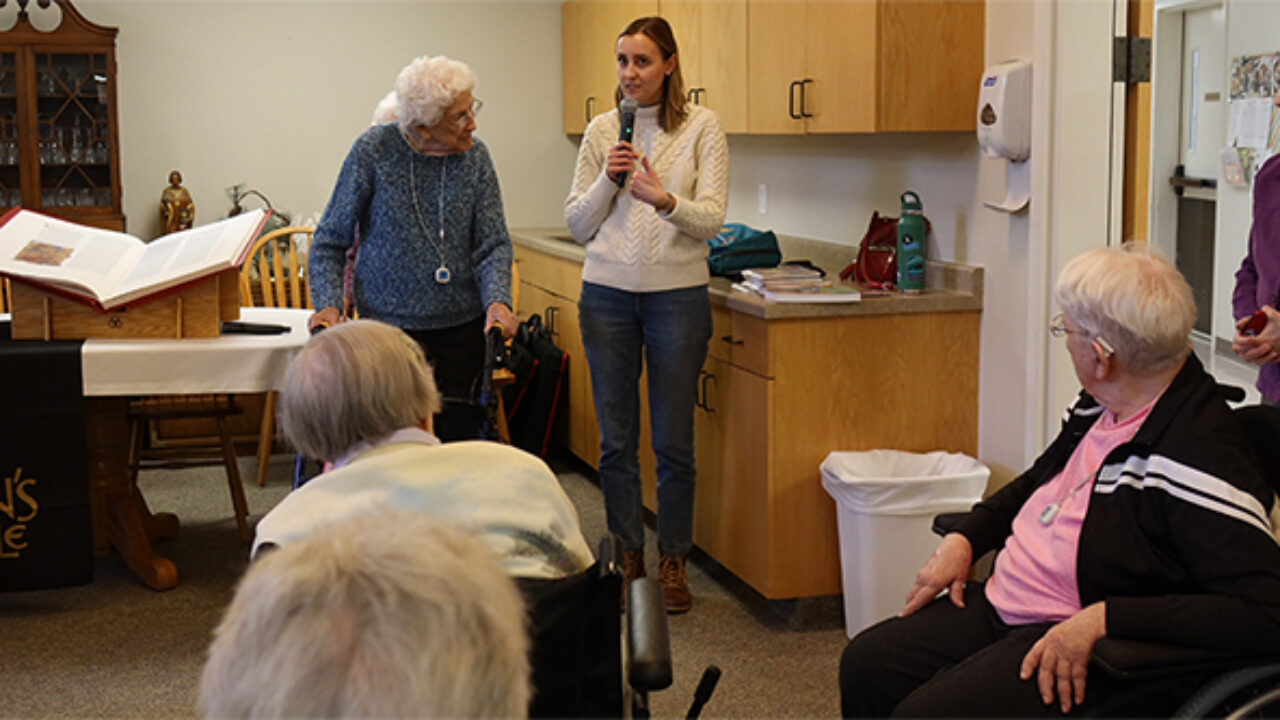Collegeville, Minnesota – One’s first encounter with The Saint John’s Bible is truly a defining experience. Whether it happens by plan or by chance, there is no denying the impact that The Saint John’s Bible can leave on those who open up their hearts and minds to experiencing it.
For Meghan Stretar, Assistant Director of The Saint John’s Bible Heritage Program, it happened by chance.

The year was 2011. Stretar, then a teenager, had just finished a day at school when her mother picked her up for a trip to the Science Museum of Minnesota. There, an exhibit featuring the Dead Sea Scrolls was on display – but this wasn’t what caught Stretar’s eye. After turning a corner, The Saint John’s Bible came into full view, the bright and vibrant pages from the Letters and Revelation volume inviting her curious gaze. The sight took her breath away.
“I grew up Catholic, so I had some understanding of the Bible, but seeing something like The Saint John’s Bible, which intersected both art and scripture, was a ‘Wow’ moment for me,” said Stretar.
When she was young, Stretar used to write down what she wanted to be when she grew up. “Artist” was the word that she documented multiple years in a row, foreshadowing the true fascination and admiration for art that she now holds in her adult life.
“Funnily enough, my first encounter with The Saint John’s Bible didn’t even cross my mind when I applied to the College of Saint Benedict. Within the first few weeks of my theology course, Tim Ternes showed up and presented an illumination to my class. I remember it was the Vision of the Valley of Dry Bones, and he talked about the symbolism in the piece. It was really powerful. I remembered then what it felt like to see The Saint John’s Bible for the first time – and how powerful that experience was for me,” said Stretar.
In the same theology course, Stretar was assigned to go to the Hill Museum & Manuscript Library and write a report about the The Saint John’s Bible gallery. The assignment was simple: choose any scripture passage and do an exegetical exercise to become an expert on it. The Saint John’s Bible took Stretar’s breath away yet again, only this time, she felt its impact even deeper.

“I found this giant piece of card stock in the bookstore and got colored pencils and markers and made my own illumination for the assignment,” said Stretar. “It really got me thinking about how art and scripture were connected – that was my first real exposure to the power of The Saint John’s Bible.”
In 2017, Stretar graduated from the College of Saint Benedict with a degree in Elementary Education. After working in a teaching position for one year, she returned to Collegeville and pursued a Master of Divinity degree with a focus on the intersection between prayer and mental health. During this time, Stretar served as Program Coordinator for the Heritage Program for two summers. She graduated with her masters in the spring of 2021.
“One afternoon, I sat down and thought: if I could have one job, what would I want it to be? And I ended up writing down ‘I would love to work with the Heritage Program’,” said Stretar. “So, I emailed Rev. Dr. John Ross, the Executive Director of The Saint John’s Bible Heritage Program, and shared my skill set, ideas, and gifts with him. I feel that the combination of my teaching background, and also having spent the last three years in a real state of discernment, helped me gain the insight and confidence to ask for this position.”
A Sense of Place
If the seed of Stretar’s passion for The Saint John’s Bible was planted at the Science Museum, then encountering the work for a second time was the water that let her passion flourish. Since joining the Heritage Program, Stretar has transitioned from being a student of The Saint John’s Bible to becoming the vessel that introduces other people to the work. In many ways, this change came naturally to her, allowing her to home in on her teaching abilities and passion for guiding others through their spiritual journeys.
“When I’m trying to help people understand what The Saint John’s Bible is, I reflect back on what it felt like for me to encounter it for the first time and try to harness that feeling again,” said Stretar. “When you’re an expert on something, it’s so easy to forget what it was like to not know anything about it. I don’t want to forget what it felt like to learn about and see the Bible for the first time because it’s a very powerful experience.”

As one of the primary resources for the Saint John’s campus as well as the 150+ existing partners and stewards of the Heritage Program, Stretar also supports efforts to bring the Bible to new communities around the world. This includes attending events such as the 2023 Parliament of the World’s Religions Conference on behalf of the Heritage Program to introduce The Saint John’s Bible to new and curious audiences.
Additionally, Stretar facilitates the “Deep Dive” experience for inquiring institutions alongside Director of The Saint John’s Bible at the Hill Museum & Manuscript Library Tim Ternes – the greatest educational opportunity for stewards to gain a deeper understanding of the complexity of The Saint John’s Bible. The experience begins with a retreat to Saint John’s University in Collegeville, Minnesota, where members of an inquiring institution explore the grounds of the campus and the history of The Saint John’s Bible.
“I find that the Deep Dive is less about telling the stewards what The Saint John’s Bible is and more about giving them the chance to experience it. It’s always so exciting to watch people see the original manuscript for the first time because they have no expectation of what it’s going to be like,” said Stretar.
When it comes to first impressions, Stretar understands more than most how important Benedictine hospitality is to the Deep Dive experience – it radically enhances one’s understanding of The Saint John’s Bible and what it means to experience it in community with others. Fully immersing participants in the experience of the Deep Dive not only showcases the heart of the Saint John’s community, but also as a place. In fact, some of the illuminations in The Saint John’s Bible feature imagery of the Saint John’s University campus and include flora and fauna native to Minnesota.
“Being at Saint John’s every day is one of the best parts of the job. In the summer and warmer months of the year, I can go out and sit with my computer down by the lake and work there –there’s just something about feeling physically grounded out in nature, surrounded by the natural beauty on campus,” said Stretar. “I feel spiritually inspired every day just being a part of this community and rubbing shoulders with members of the monastic community. It is deeply fulfilling to me to share our community at the College of Saint Benedict and Saint John’s with people from across the world through my work with the Heritage Program.”
The Saint John’s Bible Heritage Program
For more stories similar to this one, visit the Heritage Program blog, or subscribe to the program’s monthly e-newsletter, Sharing the Word.

